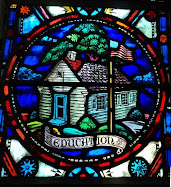Math

- Estimate the weight of a watermelon. Weigh on a bathroom scale. Figure out the price per paid per pound.
- Purchase a five pound bag of potatoes. Compare the quantity with a five pound bag of onions. Why the difference in quantity per pound? Younger children can weigh potatoes and arrange from lightest to heaviest.
- Buy a basket full of veggie. Sort according to what part of the plant is eaten: stem, leaf, seed, root, flower. Eat vegetables and dip for snack.
Language Arts
- Read Growing Vegetable Soup by Lois Ehlert. Make veggie soup for dinner. (Dad will love eating what the children learned.)
- Read the Farm Alphabet Book by Jane Miller. Make your own fruits and veggies alphabet book.
- Play Garden Match to learn beginning consonants.
- Read Eating the Alphabet: Fruits and Vegetables from A to Z by Lois Ehlert.
- Read Stone Soup by Marcia Brown (a traditional tale).
- Read Tops and Bottoms by Janet Stevens (a trickster tale).
- Make a growing vegetable soup lapbook.
- Read The Tiny Seed by Eric Carle.
Spanish
Social Studies
- Tour the produce section of the grocery store.
- Visit a working farm, garden store, orchard, or greenhouse.
Science
- Pla
nt a garden.
- Build a grow box and grow herbs.
- Spout seeds. Discuss vocabulary: seeds, seedlings, cuttings, sprout, germinate.
- Read The Vegetables We Eat by Gail Gibbons
- Read Green Beans, Potatoes, and Even Tomatoes by Brian Cleary
- Read One Bean by Anne Rockwell.
- Sprout an avocado seed.
- Grow or purchase a pie pumpkin. Open. Clean. Bake. Puree pumpkin and make bread.
- Read The Life Cycle of a Bean by Linda Tagliaferro.
- Read Foods from Farms by Nancy Dickmann.
- Read Plants on a Farm by Nancy Dickmann.
- Read Farming by Gail Gibbons. Discuss farming around the world.
- Read From Seed to Plant by Gail Gibbons.
- Read Planting a Rainbow by Lois Ehlert.
- Read The Victory Garden Vegetable Alphabet Book by Jerry Pallotta.
Arts
- Make prints using tempera paints and fruits and veggies (potato, cabbage, celery, corn, and oranges)
- Read Linnea in Monet's Garden by Christina Bjork.
- Make a seed collage.
- Sing Oats, Peas, Beans and Barley Grow. Act out the song with motions.
- Read How Are You Peeling? by Joost Effers and Saxton Freymann. Discuss the illustrations. Children may also enjoy Fast Food by the same authors.
Movement
- Play Hot Potato (hand-eye coordination)

















